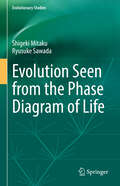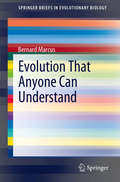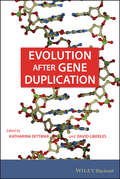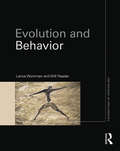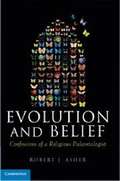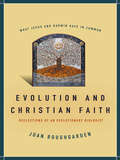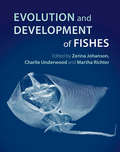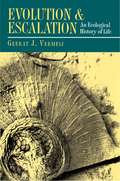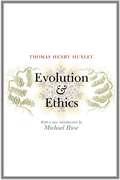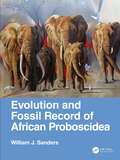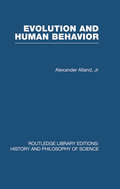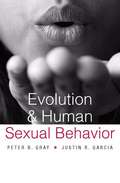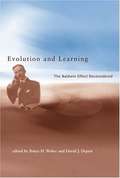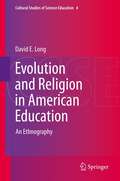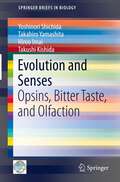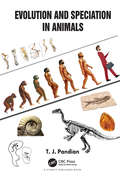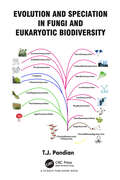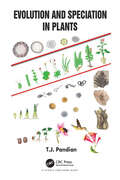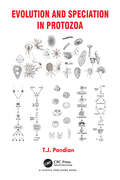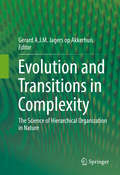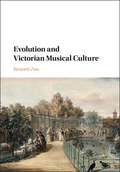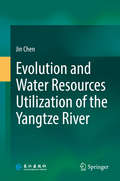- Table View
- List View
Evolution Seen from the Phase Diagram of Life (Evolutionary Studies)
by Shigeki Mitaku Ryusuke SawadaThis book aims to understand biological evolution through a physical approach, focusing on the macroscopic aspects of the biological genome. Readers will discover the connection between genomic information and the harmony of biological systems, a relationship that remains elusive to many researchers in biological sciences.The most common approach to understanding living organisms with physics is to begin with a single molecule of an organism. In contrast to this bottom-up approach, building from each molecule to the whole, this book takes a coarse-grained approach at the amino acid level to physically understand the macroscopic aspects of the organism. The book presents a system developed by the authors to predict membrane proteins with high accuracy using only physical parameters. Another distinctive perspective of this book is that it proposes the idea of a physical mechanism, other than natural selection, that orchestrates the emergence of order from random processes. The study of macroscopic aspects of living organisms based on this concept has parallels with thermostatistical mechanics for states of matter. Just as random processes create order in matter, there are physical random processes that form order in living organisms. This analogy is the central theme of the book.Using terms and analogies familiar to physicists, the book bridges the gap between biological and physical sciences. The book focuses on simple principles and is aimed primarily at researchers. While the content of this book is at the boundary area of biophysics, soft matter physics and bioinformatics, it will also be of interest to researchers and graduate students working on any biological topics.
Evolution That Anyone Can Understand
by Bernard MarcusThe function of scientific research is promoting the understanding of the world around us. In theory, anyway, the more we learn, the more potential we have of making our lives better. Thus, we have seen research in electronics provide us with computers, research in chemistry provide us with all manner of synthetics, and research in agriculture provide us with more food. Periodically, scientific research uncovers something that makes some of us uncomfortable. The discovery of the link between smoking and lung cancer and heart disease was not received well by the tobacco industry, and the link between global climate change and fossil fuel use has not been well received by the petroleum industry, to cite just two examples. Usually the response of those whose world has been disrupted by science is denial, often followed by attack on or ridicule of the science that has challenged them. In the long term, however, science usually turns out to be correct.
Evolution after Gene Duplication
by David Liberles Katharina DittmarGene duplication has long been believed to have played a major role in the rise of biological novelty through evolution of new function and gene expression patterns. The first book to examine gene duplication across all levels of biological organization, Evolution after Gene Duplication presents a comprehensive picture of the mechanistic process by which gene duplication may have played a role in generating biodiversity. Key Features: Explores comparative genomics, genome evolution studies and analysis of multi-gene families such as Hox, globins, olfactory receptors and MHC (immune system) A complete post-genome treatment of the topic originally covered by Ohno's 1970 classic, this volume extends coverage to include the fate of associated regulatory pathways Taps the significant increase in multi-gene family data that has resulted from comparative genomics Comprehensive coverage that includes opposing theoretical viewpoints, comparative genomics data, theoretical and empirical evidence and the role of bioinformatics in the study of gene duplication This up-to-date overview of theory and mathematical models along with practical examples is suitable for scientists across various levels of biology as well as instructors and graduate students.
Evolution and Behavior
by Lance Workman Will ReaderThe relationship between how we evolved and how we behave is a controversial and fascinating field of study. From how we choose a mate to how we socialize with other people, the evolutionary process has an enduring legacy on the way we view the world. Evolution and Behavior provides students with a thorough and accessible introduction to this growing discipline. Placing evolutionary psychology in context with the core areas of psychology – developmental, cognitive and social – the book explores some of the most fundamental questions we can ask about ourselves. Taking students through the principles of natural selection, it provides a nuanced understanding of key topics such as: cognitive development and the role of intelligence, memory, emotions and perception, mental health and abnormal psychology, sexual reproduction and family relationships, the development of culture. Addressing a number of controversial debates in the field, each chapter also includes concept boxes, the definition of key terms, chapter summaries and further reading. This is the ideal introductory textbook for anyone interested in evolutionary psychology. It will provide not only an essential overview of this emerging field, but also deepen readers’ appreciation of the core tenets of psychology as a whole.
Evolution and Belief
by Robert J. AsherCan a scientist believe in God? Does the ongoing debate between some evolutionists and evangelicals show that the two sides are irreconcilable? As a paleontologist and a religious believer, Robert Asher constantly confronts the perceived conflict between his occupation and his faith. In the course of his scientific work, he has found that no other theory comes close to Darwin's as an explanation for our world's incredible biodiversity. Recounting discoveries in molecular biology, paleontology and development, Asher reveals the remarkable evidence in favor of Darwinian evolution. In outlining the scope of Darwin's idea, Asher shows how evolution describes the cause of biodiversity, rather than the agency behind it. He draws a line between superstition and religion, recognizing that atheism is not the inevitable conclusion of evolutionary theory. By liberating evolution from its misappropriated religious implications, Asher promotes a balanced awareness that contributes to our understanding of biology and Earth history.
Evolution and Christian Faith: Reflections of an Evolutionary Biologist
by Joan RoughgardenClick here to visit evolutionandchristianfaith.org "I'm an evolutionary biologist and a Christian," states Stanford professor Joan Roughgarden at the outset of her groundbreaking new book, Evolution and Christian Faith: Reflections of an Evolutionary Biologist. From that perspective, she offers an elegant, deeply satisfying reconciliation of the theory of evolution and the wisdom of the Bible. Perhaps only someone with Roughgarden's unique academic standing could examine so well controversial issues such as the teaching of intelligent design in public schools, or the potential flaws in Darwin's theory of evolution. Certainly Roughgarden is uniquely suited to reference both the minutiae of scientific processes and the implication of Biblical verses. Whether the topic is mutation rates and lizards or the hidden meanings behind St. Paul's letters, Evolution and Christian Faith distils complex arguments into everyday understanding. Roughgarden has scoured the Bible and scanned the natural world, finding examples time and again, not of conflict, but of harmony. The result is an accessible and intelligent context for a Christian vision of the world that embraces science. In the ongoing debates over creationism and evolution, Evolution and Christian Faith will be seen as a work of major significance, written for contemporary readers who wonder how-or if-they can embrace scientific advances while maintaining their traditional values.
Evolution and Development of Fishes
by Zerina Johanson Charlie Underwood Martha RichterFish, or lower vertebrates, occupy the basal nodes of the vertebrate phylogeny, and are therefore crucial in interpreting almost every feature of more advanced vertebrates, including amphibians, reptiles, birds and mammals. Recent research focuses on combining evolutionary observations - primarily from the fish fossil record - with developmental data from living fishes, in order to better interpret evolutionary history and vertebrate phylogeny. This book highlights the importance of this research in the interpretation of vertebrate evolution, bringing together world-class palaeontologists and biologists to summarise the most interesting, current and cutting-edge topics in fish evolution and development. It will be an invaluable tool for researchers in early vertebrate palaeontology and evolution, and those particularly interested in the interface between evolution and development.
Evolution and Escalation: An Ecological History of Life
by Geerat J. VermeijHere is one biologist's interpretation of the chronology of life during the last six hundred million years of earth history: an extended essay that draws on the author's own data and a wide-ranging literature survey to discuss the nature and dynamics of evolutionary change in organisms and their biological surroundings. Geerat Vermeij demonstrates that escalation--the process by which species adapt to, or are limited by, their enemies as the latter increase in ability to acquire and retain resources--has been a dominant theme in the history of life despite frequent episodes of extinction.
Evolution and Ethics: And Other Essays
by Thomas Henry HuxleyHuxley's classic lecture on evolution, human nature, and the way to true happinessThomas Henry Huxley (1825–1895) was one of the most prominent evolutionists of the late nineteenth century. A close companion of Charles Darwin, Huxley developed a reputation as "Darwin's Bulldog" for his relentless defense of evolutionary theory. Huxley was also an ardent supporter of social reform, particularly in his call for quality education at all levels. Evolution and Ethics, widely considered to be his greatest lecture, distilled a lifetime's wisdom and sensitive understanding of the nature and needs of humankind. Arguing that the human psyche is at war with itself, that humans are alienated in the cosmos, and that moral societies are necessarily in conflict with the natural conditions of their existence, Huxley nevertheless saw moral dictates as the key to future human happiness and success. This beautiful edition features an introduction by renowned historian and philosopher of biology Michael Ruse, placing Huxley's lecture in its original context while showing its even deeper relevance for our own time.
Evolution and Fossil Record of African Proboscidea
by William J. SandersThis book details the long, diverse, and complex phylogenetic history of elephants and their fossil relatives (the Proboscidea), whose origin is deeply embedded some 60 million years ago in Africa. Most of the major evolutionary events of proboscideans occurred in Africa, and these are examined in their geological, paleoecological, geographic, and faunal contexts. Updated information about feeding adaptations, taxonomy and systematics, genetics, and site occurrences is included and summarized in tables, figures, and charts. This is the first comprehensive review of African proboscideans and illustrates the need to more actively protect elephants and ensure their survival in modern ecosystems. Key Features: Provides a comprehensive systematic review of the African proboscidean fossil record Includes a summary of taxonomy, geochronology, biogeography and morphology Documents major faunal events including those associated with hominin origins Synthesizes new data from genomic, isotopic, and microware analyses Emphasizes the role of elephants in ecosystems and the importance of conservation
Evolution and Holiness: Sociobiology, Altruism and the Quest for Wesleyan Perfection (Strategic Initiatives in Evangelical Theology)
by Matthew Nelson HillTheology needs to engage what recent developments in the study of evolution mean for how we understand moral behavior. How does the theological concept of holiness connect to contemporary understandings of evolution? If genetic explanations of altruism fall short, what role should we give to environmental explanations and free will? Likewise, how do genetic explanations relate to theological accounts of human goodness and holiness? In this groundbreaking work, Matthew Hill uses the lens of Wesleyan ethics to offer a fresh assessment of the intersection of evolution and theology. He shows that what is at stake in this conversation is not only the future of the church but also the fine-tuning of human evolution.
Evolution and Human Behaviour: An Introduction to Darwinian Anthropology (Routledge Library Editions: History & Philosophy of Science)
by Alex AllandOriginally published in 1967. This reprints the second edition of 1973, revised and expanded. Evolution and Human Behaviour considers man’s biological and cultural development within the framework of Darwinian evolution. Rejecting analogue models of biological evolution common in the social sciences, the author shows how the theory of biological evolution applies to the study of contemporary human behaviour.
Evolution and Human Destiny
by Fred Kohler"Evolution and Human Destiny" is a methodical examination of the evolution of living matter in general and the development of man and human society in particular. Raising pertinent questions on whether the road of human development will lead steadily upward, or whether it will be interrupted by severe setbacks with all the attendant sufferings for mankind.
Evolution and Human Sexual Behavior
by Peter B. Gray Justin R. GarciaA comprehensive survey of the evolutionary science of human sexual behavior, Evolution and Human Sexual Behavior invites us to imagine human sex from the vantage point of our primate cousins, in order to underscore the role of evolution in shaping all that happens, biologically and behaviorally, when romantic passions are aroused.
Evolution and Learning: The Baldwin Effect Reconsidered
by Bruce H. Weber David J. DepewThe role of genetic inheritance dominates current evolutionary theory. At the end of the nineteenth century, however, several evolutionary theorists independently speculated that learned behaviors could also affect the direction and rate of evolutionary change. This notion was called the Baldwin effect, after the psychologist James Mark Baldwin. In recent years, philosophers and theorists of a variety of ontological and epistemological backgrounds have begun to employ the Baldwin effect in their accounts of the evolutionary emergence of mind and of how mind, through behavior, might affect evolution. The essays in this book discuss the originally proposed Baldwin effect, how it was modified over time, and its possible contribution to contemporary empirical and theoretical evolutionary studies. The topics include the effect of the modern evolutionary synthesis on the notion of the Baldwin effect, the nature and role of niche construction in contemporary evolutionary theory, the Baldwin effect in the context of developmental systems theory, the possible role of the Baldwin effect in computational cognitive science biosemiotics, and the emergence of consciousness and language.
Evolution and Rationality
by Samir Okasha Ken BinmoreThis volume explores from multiple perspectives the subtle and interesting relationship between the theory of rational choice and Darwinian evolution. In rational choice theory, agents are assumed to make choices that maximize their utility; in evolution, natural selection 'chooses' between phenotypes according to the criterion of fitness maximization. So there is a parallel between utility in rational choice theory and fitness in Darwinian theory. This conceptual link between fitness and utility is mirrored by the interesting parallels between formal models of evolution and rational choice. The essays in this volume, by leading philosophers, economists, biologists and psychologists, explore the connection between evolution and rational choice in a number of different contexts, including choice under uncertainty, strategic decision making and pro-social behaviour. They will be of interest to students and researchers in philosophy of science, evolutionary biology, economics and psychology.
Evolution and Religion in American Education
by David E. LongEvolution and Religion in American Education shines a light into one of America's dark educational corners, exposing the regressive pedagogy that can invade science classrooms when school boards and state overseers take their eyes off the ball. It sets out to examine the development of college students' attitudes towards biological evolution through their lives. The fascinating insights provided by interviewing students about their world views adds up to a compelling case for additional scrutiny of the way young people's educational experiences unfold as they consider--and indeed in some cases reject--one of science's strongest and most cogent theoretical constructs. Inevitably, open discussion and consideration of the theory of evolution can chip away at the mental framework constructed by Creationists, eroding the foundations of their faith. The conceptual battleground is so fraught with logical challenges to Creationist dogma that in a number of cases students' exposure to such dangerous ideas is actively prevented. This book provides a detailed map of this astonishing struggle in today's America--a struggle many had thought was done and dusted with the onset of the Enlightenment.
Evolution and Senses
by Yoshinori Shichida Takahiro Yamashita Hiroo Imai Takushi KishidaThis book focuses on sensing and the evolution of animals. Using the five senses (visual, auditory, and olfactory perception, and taste and touch), animals can receive environmental stimuli and respond to them. Changes in these sensitivities might cause changes in aspects of animals' lives such as habitat, activity timing, and diet--and vice versa. Recent advances in genome and molecular analysis enable us to investigate certain changes in the receptors or mechanisms involved in sensing and provide clues for understanding the evolution of animals related to those changes. The first chapter deals with the molecular evolution of opsins. In addition to the well-known function of opsins as visual receptors, opsins can be related to non-visual photoreception such as photoentrainment of circadian rhythm, photoperiodism, and background adaptation. Molecular phylogenic studies reveal that all opsin genes have evolved from one ancient opsin gene. The evaluation of the functions of each extant opsin protein based on the molecular features enables us to predict the molecular evolution and diversification of opsins during the evolution of animals. These studies shed light on which amino-acid substitutions cause the functional diversification of opsins and how they have influenced the evolution of animals. The second chapter has to do with bitter taste perception, a key detection mechanism against the ingestion of bioactive substances. Genetic and behavioral evidence reveal the existence of "non-taster" Japanese macaques for specific bitter compounds, which originated in a restricted region of Japan. This finding might provide a clue for elucidating the ecological, evolutionary, and neurobiological aspects of bitter taste perception of primates. The third chapter presents an extreme example of the evolution of olfaction, namely, that fully aquatic amniotes have generally reduced their olfactory capacity considerably compared to their terrestrial relatives. Interestingly, the remaining olfactory abilities are quite different among three fully aquatic amniotes investigated: toothed whales have no nervous system structures that mediate olfaction, but baleen whales can smell in air, and it has been suggested that sea snakes smell underwater.
Evolution and Speciation in Animals
by T. J. PandianThis book represents the first attempt to quantify environmental factors and life history traits that accelerate or decelerate species diversity in animals. About 15%, 8% and 77% of species are distributed in marine (70% of earth’s surface), freshwater (terra firma fosters more diversity. The harsh hadal, desert and elevated montane habitats restrict diversity to 0.5-4.2%. Costing more time and energy, osmotrophic and suspension modes of food acquisition limit diversity to Selfing hermaphrodites (0.9%), parthenogens ( Incidence of heterogamety is four-times more in males than in females. Hence, evolution is more a male-driven process. Egg size is determined by environmental factors, but lecithality is genetically fixed. In poikilotherms, sex is also determined by gene(s), but differentiation by environmental factors. The extra-ovarian vitellogenesis (> 96%), spermatozoan (81%) rather than spermatophore mechanism of sperm transfer, promiscuity and polygamy over monogamy, iteroparity (99.6%) over semelparity and internal fertilization (84%) are preferred, as they accelerate diversity. Body size and egg size determine fecundity. Indirect life cycle (82%) and incorporation of feeding larval stages accelerate diversity. Brooding and viviparity (6.4%) decelerate it. Parasitism extends life span and liberates fecundity from eutelism. Evolution is an ongoing process, and speciation and extinction are its unavoidable by-products. The in-built conservation mechanism of reviving life after a sleeping duration has been reduced from a few million years in microbial spores to a few thousand years in plant seeds and a few hundred years in dormant eggs in animals. Hence, animal conservation requires priority. The existence of temperature-resistant/insensitive individuals, strains and species shall flourish during the ongoing global warming and earth shall continue with such burgeoning species, hopefully inclusive of man.
Evolution and Speciation in Fungi and Eukaryotic Biodiversity
by T. J. PandianBeing sessiles like autotrophic plants and heterotrophics as animals, fungi are fascinating eukaryotes. In them, the need for external digestion has demanded surface expansion and limited tissues to 2/y. The mycorrhizas facilitate 85% angiosperms to acquire water and minerals, enhance productivity and fight against drought and pollutants. During the geological past, lichens have weathered rock and formed the present landscape. Only 121 fungal species excrete digestive enzymes to meet industrial demand. The beneficial fungi contribute 1,000 billion US$. Parasitic fungi cause 1.6 million human deaths and > 20% loss of commercial crops. Despite their ecological and economic importance, no university offers a degree course in Mycology. For 2,056,907 eukaryotic species, this book elaborates the role played by environmental factors (i) spatial distribution, (ii) light-temperature, (iii) precipitation-liquid water and biological attributes, (iv) cellularity, (v) symmetry, (vi) clonality, (vii) sexuality, (viii) modality and (ix) motility that either accelerate or decelerate biodiversity. About 20 and 80% eukaryotes are aquatics and terrestrials. Decreasing light intensity and temperature reduce diversity from the equator toward the polar zones. Water availability also reduces the diversity from 5.4 - 65.5 species/km2 in tropical evergreen forests to 2 in deserts and polar zones. Unicellularity and radial symmetry decelerate the diversity to 200 in mammals reduce clonality from 100 to 0%. Strategies developed by eukaryotes reduce selfing by
Evolution and Speciation in Plants
by T.J. PandianPlants are autotrophs and sessile, while animals are heterotrophs and motile. Sessility has imposed on plants 94% hermaphroditism, 23% selfing, 3% polyploidization and 39% clonality, in comparison to 19 and
Evolution and Speciation in Protozoa
by T.J. PandianThe polyphyletic Protozoa have explored the possibility of performing almost all metazoan functions with a few subcellular organelles. Their unicellularity and structural simplicity have (i) limited diversity to 32,950 species, (ii) restricted spatial distribution to aquatic habitats (94%, against 15% in Metazoa), (iii) demonstrated the ubiquitous dominance of clonality, (iv) reduced sexualization in 50% species, (v) facilitated the use of vegetative gametes in 40% species and (vi) secondary loss of sex in 10% species. With the fastest multiplication rates, i.e. once every 6-60 hours, they occur in high densities of 105-106 cell/ml. Their diverse and complicated life cycles are described in 30 types. Being risky, the cycle involves two hosts in clonality > hermaphroditism > motility. Motility ranges from 2-3 μm for Rhizopoda to 400-2,000 μm for Ciliophora. Not surprisingly, 6,800 species of arcellinids, filosians and formainifers are testated or shelled. Within 1,229 sessile species, the peritrichid and suctorian ciliates are better adapted to coloniality. Unlike those of many Metazoa, the protozoan cyst is a dynamic stage, in which clonal or sexual reproduction occurs. Over 81% protozoans encyst, as it ensures (i) 90% survival during unfavorable conditions (against 15 in 12% non-encysted protozoans), (ii) genome transfer through generations, (iii) dispersal into new habitats and (iv) transmission to new hosts. Their mean body size ranges from 2 μm to 2 mm – a range over 1,000-times – only 8% aquatic metazoans cover a similar size range. In comparison to 77% macrophagy in Metazoa, only 46% protozoans are macrophagous predators. Within motile microphagy, protozoans filter 3-2 times smaller food particle at 50% cheaper clearance cost. This efficiency has expanded microphagy to 15% in protozoans, against 3% in Metazoa. Hence, their turnover rate in trophic dynamics is twice faster than that of metazoans. Foraminifers serve as ecological sensitive indicators in petroleum exploration and rise in sea level. For the first time, incidences of clonality and meiosis as well as symbiosis and parasitism have been shown to hint at the origin and evolution of different protozoan taxonomic groups during the geological past.
Evolution and Transitions in Complexity
by Gerard A.J.M Jagers op AkkerhuisThis book discusses several recent theoretic advancements in interdisciplinary and transdisciplinary integration in the field of evolution. While exploring novel views, the text maintains a close link with one of the most broadly held views on evolution, namely that of "Darwinian evolution. " This work puts forth a new point of view which allows researchers to define in detail the concept of evolution. To create this conceptual definition, the text applies a stringent object-based focus. With this focus, the editor has been able to develop an object-based pattern of evolution at the smallest scale. Subsequently, this smallest scale pattern is used as an innovative basis for generalizations. These generalizations create links between biological Darwinism and generalized Darwinism. The object-based approach that was used to suggest innovations in the field of Darwinian evolution also allowed for contributions to other topics, such as major evolutionary transitions theory, the definition of life and the relationships between evolution, self-organization and thermodynamics. Together, the chapters of this book and the multidisciplinary reflections and comments of various specialists on these chapters offer an exciting palette of innovative ideas.
Evolution and Victorian Musical Culture
by Bennett ZonThis engaging book explores the dynamic relationship between evolutionary science and musical culture in Victorian Britain, drawing upon a wealth of popular scientific and musical literature to contextualize evolutionary theories of the Darwinian and non-Darwinian revolutions. Bennett Zon uses musical culture to question the hegemonic role ascribed to Darwin by later thinkers, and interrogates the conceptual premise of modern debates in evolutionary musicology. Structured around the Great Chain of Being, chapters are organized by discipline in successively ascending order according to their object of study, from zoology and the study of animal music to theology and the music of God. Evolution and Victorian Musical Culture takes a non-Darwinian approach to the interpretation of Victorian scientific and musical interrelationships, debunking the idea that the arts had little influence on contemporary scientific ideas and, by probing the origins of musical interdisciplinarity, the volume shows how music helped ideas about evolution to evolve.
Evolution and Water Resources Utilization of the Yangtze River
by Jin ChenThis book provides a comprehensive overview of the Yangtze River system and its water resources development and management. From the perspectives of geology, hydrology, zoology, ecology, it discusses the Yangtze River’s geological history and aquatic environments, analyses the endangered species along the river basin, and reviews the effects of human hydrolytic activities on its ecosystem. By studying the history of Yangtze River system and its water resources development, it provides insights into the effects of evolution and human activities on the ecosystem of its basin, and offers strategic thoughts on conservation and sustainable development of the Yangtze River.Written by an author with extensive experience in the field, this book is an invaluable reference resource for researchers interested in the Yangtze River.
